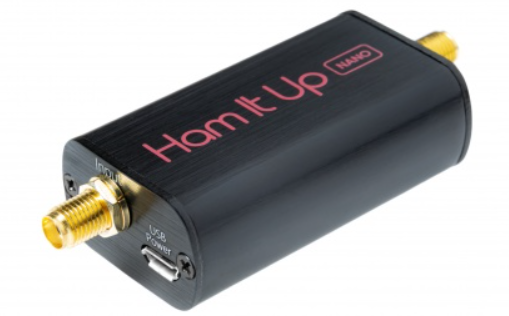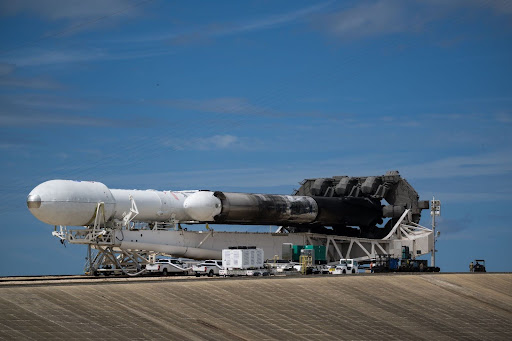![]()
Unfold the Hidden Radio Spectrum with the Ham It Up Nano

If you have ever craved the ability to explore a wider range of the radio spectrum with your SDR (Software Defined Radio)? This tiny powerhouse significantly expands your SDR’s reach, allowing you to delve into the fascinating world of Low Frequency (LF), Medium Frequency (MF), and High Frequency (HF) signals, all the way down to 100kHz. Many SDRs excel at receiving signals in the VHF/UHF range (Very High Frequency/Ultra High Frequency). The Ham It Up Nano acts as an upconverter. It takes those low HF signals and “boosts” their frequency, effectively translating them into a range your SDR can readily understand.
Enter the Nooelec Ham It Up
Recently, the Nooelec company sent me a Ham It Up Nano to test and evaluate.
Testing.
Using SDR Sharp as my software of choice I set the Frequency offset (see description below), connected my Nooelec SmarTee XTR to the IF Output side of the Ham It Up Nano, and, using an SMA barrel connector, connected a Balun One Nine – 1:9 HF Antenna Balun to the IF Input side of the Ham It Up Nano. My Balun One Nine is connected to a simple long wire antenna in my yard, about 54′ in length.
Starting the SDR# software I was immediately rewarded in the AM spectrum and was soon listening to many AM Stations I previously could not receive. But the real fun started in the shortwave radio ranges, and I was soon picking up shortwave radio from South America, and shortwave operators from New Brunswick and Mexico.

Night and Day Difference:
Before the Ham It Up Nano, I relied on my RTL-SDR in direct-sampling mode. It captured signals weakly, but only with my long-wire outdoor antenna. The Ham It Up Nano is a game-changer! Experimentation further revealed that I can pick up the same signals with a compact indoor antenna, often with an even better signal-to-noise ratio (SNR).
The production model:
I did not have time to analyze the signal, but rather watched the SNR, the waterfall display and, more importantly listening to the signal as it came in. The production model currently available did very well, I did notice an improvement in the signal. Apparently the new filters on the board are more efficient, and the signal had a bit higher SNR and the random static that seems to plague LF, MF, and HF frequencies were attenuated down quite a bit. Atmospherics can greatly affect shortwave, so I did my test all within a 60-minute time period, switching out the Ham It Up unit and trying direct sampling every 10 minutes while keeping the power on to the SmarTeeXTR to help avoid any drift while ‘warming’ up. On the current production model, it seems that the local oscillator has minuscule drift, which makes it slightly harder to tune accurately to SSB signals, however, with the SDR# software this was not an issue.
Overall Review –
Small in Size, Giant in Capability
The Ham It Up Nano is incredibly compact and lightweight, measuring just 2 inches by 1.2 inches. This Tiny HF Upconverter packs a powerful punch. Here’s how it elevates your SDR experience:
- Unveils Hidden Frequencies: By acting as an upconverter, it translates lower frequencies into a range your SDR can easily detect, opening doors to a treasure trove of radio signals you might have missed before.
- Dual Functionality: Not only does it function as an upconverter, but it can also act as a panadapter, providing a visual representation of the radio spectrum. This makes it a breeze to identify and tune into specific signals.
- Broad SDR Compatibility: Works seamlessly with popular SDRs like the NESDR series and the HackRF, making it a versatile tool for your radio adventures.
- Flexible Power Options: Provides you with the freedom to choose your power source. You can choose from bias-tee, micro USB, or a DC barrel connector, making it adaptable to various use cases.
Built to Last, Engineered to Impress
The Ham It Up Nano isn’t just feature-rich, it’s also built tough. Here’s what makes it a reliable companion for radio exploration:
- Rugged Construction: Housed in a heavy-duty black aluminum enclosure, it can withstand the bumps and jostles of mobile use.
- Double Shielded Defense: Shielded with both an external aluminum enclosure and an internal shield, it effectively guards against unwanted RF interference, ensuring pristine signal reception.
- Ultra-Precise Performance: Contains a high-quality 125MHz TCXO (Temperature-Controlled Oscillator) that boasts an impressive 1PPM accuracy, leading to enhanced sensitivity, especially in noisy environments.
- Top-Notch Components: Throughout the device, you’ll find meticulously chosen, ultra-high-quality components that contribute to exceptional sensitivity and selectivity.
- Multi-Level Protection: Protects your SDR and itself from various threats. ESD (Electrostatic Discharge) protection safeguards against static shocks, while reverse voltage and short circuit protection shield it from accidental damage during USB power connection.
- Clean Power Delivery: An ultra-low-noise linear power regulator ensures a clean and steady power supply, minimizing noise levels for optimal performance.
- High-Quality Construction: The PCB (Printed Circuit Board) boasts an ENIG finish, further contributing to the device’s overall quality and durability.
- 2-Year Warranty: Backed by a reassuring 2-year warranty, you can be confident in your investment.
Caution ESD Protection and DC Blocking-
| The Ham It Up Nano works great with most SDRs, but some SDRs have ESD (Electrostatic Discharge) protection that might react to the USB power from the Nano. This can cause issues. If necessary you’ll need a DC block between the Ham It Up Nano and your SDR. This tiny component acts like a filter, letting the radio signal pass through while blocking the DC (direct current) from the USB power. Two ways to get a DC block: DIY (for electronics enthusiasts): Put a high-quality capacitor in series with the RF path. This acts as a DC block. Pre-made option: Nooelec sells a high-quality SMA DC block for a quick and easy solution. Adding a DC block prevents ESD problems and ensures your SDR and the Ham It Up Nano work together smoothly. |
Simple Setup:
- NESDR/ DRFirst: Ensure your NESDR or SDR is up and running first.
- Connect the Gear: Now, connect your antenna to the Ham It Up Nano’s RF input and your NESDR or SDR to the IF output.
- Power Up: If needed with your SDR, enable bias tee, or, plug the USB power source into the Ham It Up Nano.
- Software Time: Launch your preferred SDR software.
Tuning In:
Here’s the magic:
- Offset Approach: Most software offers an offset function. Enter a negative offset of -125,000,000 Hz (equivalent to -125 MHz). This accounts for the Ham It Up Nano’s internal LO (Local Oscillator) frequency of 125 MHz.

- Manual Tuning (Optional): If your software doesn’t have an offset feature, you can manually add 125 MHz to your desired frequency. For example, to tune to a 620 AM radio station, enter 125,620,000 Hz (125.620 MHz).
Ready to Explore!
With these steps, you’re ready to delve into the hidden world of radio frequencies. Remember, the chosen tuning method (offset or manual) depends on your SDR software capabilities. Now, fire up your software and enjoy the newfound range of signals your NESDR and SDR can access.
Amplification?
The Ham It Up Nano focuses on converting, not amplifying, radio signals. Here’s why:
- Amplification Challenges: While amplification might seem beneficial, it can introduce more problems than it solves in the High Frequency (HF) range. It can distort signals and make them harder to understand.
- Strategic Placement: The Ham It Up Nano is designed to be positioned near your SDR for optimal performance. Amplification, if needed, should ideally be placed closer to the antenna for better signal strength before it travels through cables.
Considering Amplification?
If you absolutely need some amplification, I recommend a cautious approach:
- Start Small: Begin with a low amplification level, ideally around 10dB or less.
- Beware of Overload: Excessive amplification can overload the Ham It Up Nano, leading to performance issues or permanent damage.
Remember: The Ham It Up Nano excels at converting weak signals into a range your SDR can comprehend. Amplification might not be necessary, and if it is, proceed with caution!!




